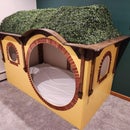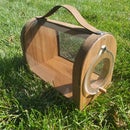Introduction: Bolt Together 2 X 72 Belt Grinder
I have been wanting a 2 x 72 belt grinder ever since I started making knives on my wimpy 4 x 36 belt sander. After looking around at some designs I figured I could probably make one myself. I had access to our scrap bin at work that often had square tubing and small chunks of flat stock but I didn't have access to a welder. This led me to design a belt grinder that was similar to many of the welded designs I saw but would be bolted together rather than welded. This also had the advantage that if one of the pieces broke or I messed up on it while making it then all I had to do was unbolt it and make a new one.
Here are some sites that I referenced when designing this. They have additional information that I may not include that may help you out.
https://www.instructables.com/id/2X72-Belt-Grinder...
Step 1: Drawings and Models
Below I have included some drawings and models that should hopefully help you with the dimensions and hole layouts. I included the drawings as pdf's and the .step file for the entire assembly so you can see how it all fits together. If you do not have a 3D modeling software I have also included a 3D pdf that will anyone with adobe acrobat (its free) to be able to view the assembly as well.
Note: While making this I made some changes and these drawings and models are not 100% the same as what I show being made. I will address the changes in each step as they differ from the drawings.
Material List:
2in x 2in square tubing in the following lengths:
One 5in long tube
Two 10in long tubes
One 11in long tube
1.5in x 1.5in square tubing in the following lengths:
One 7in long tube
One 17in long tube
One 12in long tube
Two pieces 2in x 6.5in x .25in (this can be thinner but it is nice if it is thicker because it will be threaded)
Two pieces 4in x 4in x .125 (this can be thicker if you want but not any thinner)
Four 2in long pieces of 2in angle iron
One piece at least 2.5in x 8in x .25in for the tool rest
One piece 2in x 2in x .25in (I made mine more around 2in x 4in x .25in which you will see later)
One piece 1.5in x 1.1in x .375in for one half of the hinge
One piece 2in x 2in x .375in for the other half of the hinge
Parts list:
Lots of bolts (each step will show the bolts you need, most are 3/8in bolts but they don't have to be)
Lots of lock nuts (these are important as this vibrates a lot and you don't want it coming apart)
Two adjustable position handles (I used these 3/8 x 1 1/4 ones)
Flat platen tool (I bought this one but the second link I provided has the plans for one if you can make it)
Guide, tracking, and drive wheels (I bought mine form here but the third link shows how you can make your own)
A gas spring (I used a 7in 100N/22lb spring from amazon but it is no longer available)
A handle (I turned a 2 x 2 piece of wood into a handle but you could buy whatever you want)
A motor (This completely depends on what you have or the power you want, I have a 1hp motor with a vfd to provide variable speed control)
Attachments
Step 2: Making and Attaching the Front Plate
I forgot to take pictures before I drilled all of the holes but I tried to show them in a way that would explain the step by step approach that I took when making this.
First you need to cut all 4 of the 2in square tubing to the required lengths. For the two 10in tubes you will want to file away the weld seam because this is where the 1.5in tubes will be inserted and that seam will make it difficult. These tubes have a 3/16in wall thickness. It is important to have thicker walls on these because the 1.5in tubes fit into them and you want as small of a gap as possible.
The next part that I show was originally designed to be 2in x 2in but I ended up making it 4in long because as you will see later on I needed to room so that I could have a surface to mount the gas spring to. When making this part you need a drill press because you are drilling all the way through a 2in part and unless you are way better at free hand drilling than I am it is near impossible to drill through this evenly. I drilled these to allow a 1/4in bolt to fit all the way through this and the two side plates. Many of these holes can be drilled slightly larger than the bolt so that even if you are a little off then it can still be assembled. when you tighten everything down it will be tight enough that nothing will move.
Then you will want to drill the holes on the two side plates. One plate will be drilled to have two 3/8 in threaded holes in it and the other I decided to put two 1/4in threaded holes in it even though I didn't have them on the drawing. These 1/4in bolts were used to keep these plates fixed to the two 10in tubes. Then you will put a 3/8in hole in the bottom that will hold the front leg in place.
Assemble as shown and then drill the hole in the front leg, this tube also had a 3/16in wall thickness, and bolt it together. once this is bolted together then you will want to use the holes on the plates as guides on where to drill the holes on the tubes below them. Then you tap the holes and add the bolts and handles. If you need to learn how to tap a hole it is included in the classes they offer on here. Just go slow as I broke a tap while making this.
Step 3: Making and Attaching the Rear Plate
Now to work on the back side. For the 11in tube you will need to cut out the top to allow the top arm to be able to fit into it. This tube only had a 1/8in wall thickness due to the material I had available but it is not as important as on the two 10in tubes.
Then you will need to create the two 4in x 4in plates. These hold the back and together. It worked best be me to drill the top hole in the vertical 11in tube and then put the bolt through and then use the plate to mark the second holes location. I did the same thing for the next two holes through the other tubes. Then you just bolt it all together.
Step 4: Making the Hinge for the Tracking Wheel
To be able to adjust the tracking of the belt, the tracking wheel needed to be mounted onto a hinge. I decided to make my own hinge because I had a small desktop mill available and the steel to make it. This hinge just needs to be able to attach to the upper arm and the other half of the hinge has to be able to hold the bolt that the tracking wheel spins on.
Step 5: Making the Upper Arm
To make the upper arm you will need the 7in long piece of 1.5in tube. The 1.5in tubes I had all had a 3/16in wall thickness. This will fit into the back 11in tube where the slot was cut out. The holes in the back are where a bolt will go through to allow it to rotate up and down. When fully assembled this arm is pushed up by the gas spring and provides the tension on the belt. You will then need to drill the holes for the hinge and handle.
Because there is a gap when this is inserted into the 11in tube I bought some nylon spacers ans sanded them down so that they would take up the gap between these two parts.
For my handle I just turned a 4in piece of 2x2 wood that I had laying around and drilled a hole through it so I could run a 1/4in bolt through to attach it to the tube. You can buy a handle or make one however you want. it is just needed to pull down on the arm when changing belts.
Note: I talk about it in the trouble shooting section but I would recommend making the arm a couple inched longer and moving the handle up further allowing for the addition of a tracking adjustment knob.
Step 6: Making the Feet
To be able to mount this to a surface it needed some feet. I had access to some 2in angle iron so that is what I made these out of. They are all 2in wide and have a 3/8in hole on each face. one hole to mount to the belt grinder and one to bolt into the table I mount it on.
Step 7: Making the Tool Rest
To make a tool rest for this I needed a long piece of 1.5in tubing to insert into the lower of the two 10in tubes. I determined this needed to be about 17in in length to sit in the right location. I then found a good sized piece of flat stock and drilled and tapped two holes and then used those holes as guides to drill the holes in the 1.5in tube. I then fed two bolts in through the bottom and ground them so that they would not stick up out of the plate.
Note: When figuring out where to drill the holes on the flat stock it is important to note where the belt will be and center your plate about that point so that you have that same amount of tool rest to either side of the belt. Unless you want it uneven, in that case do it however you want.
Step 8: Making the Flat Platen Tool Arm
To make the other tool arm you will need to know what you plan on mounting to it. I was going to mount a flat platen to it so I used the hole locations from that to determine where I needed to drill my holes. If you use a different mount than the one I used you will need to determine where your holes will need to be accordingly. You can make multiple arms to accommodate additional things like a large or small contact wheel. I found that 12in was the length needed for the flat plated attachment I used but you may need something longer or shorter depending on what you plan on attaching to it.
Step 9: Attaching the Gas Spring for Belt Tension
I determined I needed a 7in long gas spring to keep the upper arm at the angle I wanted. This is why I ended up making the top of the front plate 4in long instead of 2. I needed room to mount the gas spring. This was simply just figuring out where I wanted it to be positioned and then drilling and tapping the holes for the screws to hold it in place.
Note: be careful when drilling the holes in the plate so that you don't drill into where the other bolts are in that plate already.
Step 10: Trouble Shooting
There were a couple things that I ran into that I would like to make note of to help you in setting up your grinder.
- Make sure all the wheels are aligned correctly. I had to drill the holes in the top arm bigger for the hinge because it had enough wiggle that the weight of the tracking wheel and tension of the belt bulled it down too much. I just made the holes bigger and twisted the hinge some more before bolting it down. I also had to do some troubleshooting to make sure the motor was aligned correctly so that the drive wheel was in the correct alignment with the rest of the wheels.
- The tracking wheel will need to be pushed out some to track correctly. I didn't fully understand this part of the grinder when designing it but to adjust the tracking of the belt the tracking wheel will need to be pivoted on the hinge either in or out to adjust the belt. I did not add this kind of feature when I designed this but I would suggest making the upper arm longer and mounting the handle at the top making room for a handle with a threaded rod to be added that can be twisted to push the tracking wheel in or out. For now I just drilled a hole in the hinge and added a threaded stud that can be twisted to push it in or out but it is a pain to adjust.
- There may be clearance between the tool arms and the 10in tubes they go into. I got some 1/16in thick nylon sheets that I cut into strips to fill the space between those parts to prevent the tool arms from being able to wiggle due to the clearance between them.
Step 11: Fully Armed and Operational Belt Grinder
Your grinder is now complete and all you need to do is add a motor, set it all up, and you are ready to grind away.
If you want you can get some 1.5in square tube plugs to cap the exposed ends of the 1.5 tubes just to clean it up. I plan on adding those and painting it next year when it warms up again.
Thank you for checking this out. If you have any questions, comments, or improvement suggestions please let me know.
Step 12: Updated Design
It took me long enough but I finally got around to updating the upper arm on my grinder. As you can see from the pictures, I made a new tube that is about 5 inches longer so that I could move the handle to the end and make room for a bolt that would allow me to adjust the tracking wheel more easily. I just plan on 3D printing a knob to fit on to the end of the bolt to make it so I can turn it by hand instead of with a wrench.

First Prize in the
Metal Contest 2017















